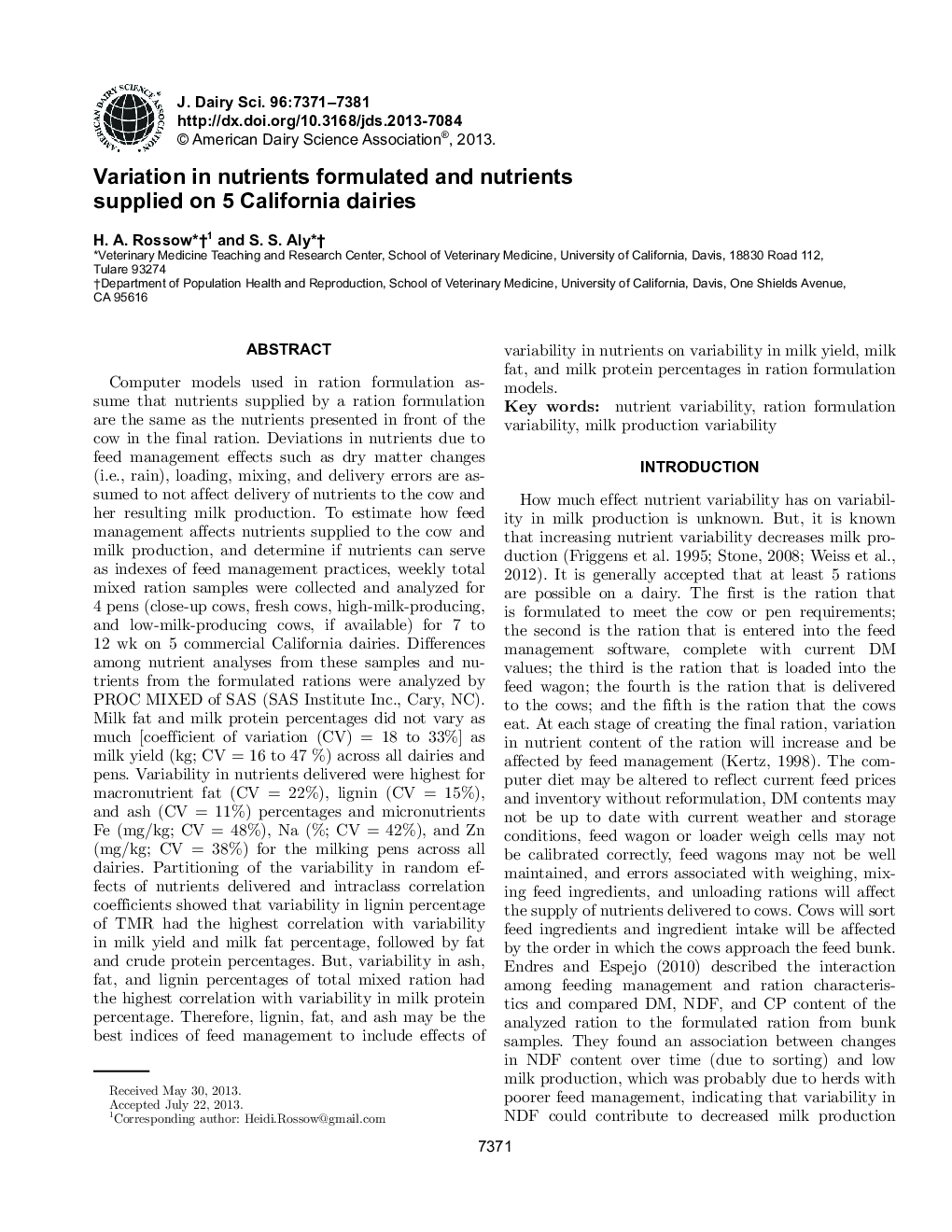| کد مقاله | کد نشریه | سال انتشار | مقاله انگلیسی | نسخه تمام متن |
|---|---|---|---|---|
| 5789584 | 1108030 | 2013 | 11 صفحه PDF | دانلود رایگان |
عنوان انگلیسی مقاله ISI
Variation in nutrients formulated and nutrients supplied on 5 California dairies
ترجمه فارسی عنوان
تغییر در مواد مغذی فرموله شده و مواد مغذی موجود در 5 گاوداری کالیفرنیا
دانلود مقاله + سفارش ترجمه
دانلود مقاله ISI انگلیسی
رایگان برای ایرانیان
کلمات کلیدی
تغییرات مواد مغذی، تنوع فرمولاسیون جیره، تنوع تولید شیر،
موضوعات مرتبط
علوم زیستی و بیوفناوری
علوم کشاورزی و بیولوژیک
علوم دامی و جانورشناسی
چکیده انگلیسی
Computer models used in ration formulation assume that nutrients supplied by a ration formulation are the same as the nutrients presented in front of the cow in the final ration. Deviations in nutrients due to feed management effects such as dry matter changes (i.e., rain), loading, mixing, and delivery errors are assumed to not affect delivery of nutrients to the cow and her resulting milk production. To estimate how feed management affects nutrients supplied to the cow and milk production, and determine if nutrients can serve as indexes of feed management practices, weekly total mixed ration samples were collected and analyzed for 4 pens (close-up cows, fresh cows, high-milk-producing, and low-milk-producing cows, if available) for 7 to 12Â wk on 5 commercial California dairies. Differences among nutrient analyses from these samples and nutrients from the formulated rations were analyzed by PROC MIXED of SAS (SAS Institute Inc., Cary, NC). Milk fat and milk protein percentages did not vary as much [coefficient of variation (CV)Â =Â 18 to 33%] as milk yield (kg; CVÂ =Â 16 to 47 %) across all dairies and pens. Variability in nutrients delivered were highest for macronutrient fat (CVÂ =Â 22%), lignin (CVÂ =Â 15%), and ash (CVÂ =Â 11%) percentages and micronutrients Fe (mg/kg; CVÂ =Â 48%), Na (%; CVÂ =Â 42%), and Zn (mg/kg; CVÂ =Â 38%) for the milking pens across all dairies. Partitioning of the variability in random effects of nutrients delivered and intraclass correlation coefficients showed that variability in lignin percentage of TMR had the highest correlation with variability in milk yield and milk fat percentage, followed by fat and crude protein percentages. But, variability in ash, fat, and lignin percentages of total mixed ration had the highest correlation with variability in milk protein percentage. Therefore, lignin, fat, and ash may be the best indices of feed management to include effects of variability in nutrients on variability in milk yield, milk fat, and milk protein percentages in ration formulation models.
ناشر
Database: Elsevier - ScienceDirect (ساینس دایرکت)
Journal: Journal of Dairy Science - Volume 96, Issue 11, November 2013, Pages 7371-7381
Journal: Journal of Dairy Science - Volume 96, Issue 11, November 2013, Pages 7371-7381
نویسندگان
H.A. Rossow, S.S. Aly,
